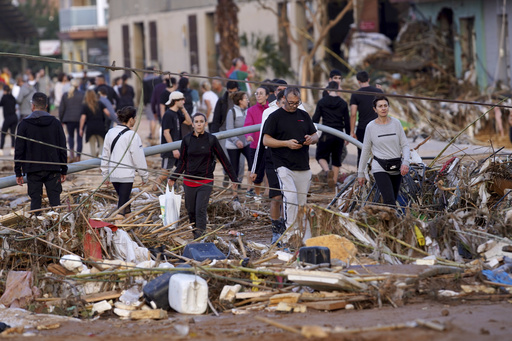
This autumn has brought particularly severe weather conditions, further intensifying in regions already struggling with rain, particularly in Europe. The latest instance of this situation is seen in Spain’s Valencia region, where catastrophic flooding has resulted in the tragic deaths of at least 95 individuals. The floods have wreaked havoc, with vehicles strewn along the coastline like detritus. Meanwhile, much of the United States is experiencing an exceptionally dry October, resulting in a significant drought in various areas.
Experts working to understand these weather phenomena, especially the deadly torrential rains in Europe, have identified two probable links to climate change induced by human activities. The first connection is that warmer atmospheric conditions can hold and subsequently release more rain. The second is related to alterations in the jet stream—the high-altitude air current that influences weather patterns around the world—which may lead to more extreme weather events.
Meteorologists and climate scientists have pointed to a phenomenon known as a cut-off lower pressure storm system as the immediate cause of the flooding in Spain. This system developed due to a notably erratic and stagnant jet stream, leading to prolonged periods of rainfall over the area. In Spain, these weather patterns are commonly referred to as DANAs, based on the Spanish acronym for the storm system. Conversely, in the United States, a stable high-pressure system has created dry conditions, effectively preventing storm development.
Jeff Masters, a meteorologist associated with Yale Climate Connections, emphasized the interconnectedness of weather patterns, stating, “If we’re experiencing dryness, it means others are experiencing heavy rainfall.” Jennifer Francis, a climate scientist at the Woodwell Climate Research Center, echoed this sentiment, asserting that the same complex jet stream pattern causing drought in the U.S. is also fueling devastating floods in eastern Spain. Francis’s theory, which links the slow-moving and wavy jet stream to climate change impacts, is gaining traction, though it remains a topic of debate within the scientific community.
Maria Jose Sanz, scientific director of the BC3 Basque Center for Climate Change, commented on the jet stream’s unpredictability, indicating that climate change is resulting in more noticeable fluctuations. This increased waviness can lead to weather patterns that linger in one location for extended periods, contributing to events like the DANAs.
Though not entirely convinced by the wavy jet stream theory, Erich Fischer, a climate scientist at ETH Zurich, noted the numerous cut-off low storm systems that have afflicted Europe this fall, including deluges in parts of France, Italy, Austria, and the Czech Republic. Such events are not limited to autumn; similar storms have been reported throughout the summer months in the Alps, indicating a rise in extreme weather occurrences.
Without necessarily attributing these phenomena directly to changes in the jet stream, several scientists concur that basic physical laws contribute to increased storm intensity. Specifically, the Clausius-Clapeyron equation reveals that for every degree Celsius of warming, the atmosphere can hold 7% more moisture, leading to increased precipitation. As global temperatures have risen approximately 1.3 degrees Celsius due to greenhouse gas emissions, rain intensity has consequently escalated, as confirmed by climate scientist Friederike Otto from Imperial College.
“It is unequivocally clear that climate change influences these severe events,” Otto stated, particularly regarding the abrupt bursts of rain seen in Valencia. The process of moisture condensing releases heat energy, which can enhance storms, resulting in increased uptakes of moisture and intensifying rainfall by as much as 20%, as explained by meteorologist Masters.
Fischer highlighted a comparable storm that struck in 1957, but pointed out that this year’s storm brought significantly more rain due to the warmer atmospheric conditions. While the 1957 event produced around 10 inches of rain, this recent storm recorded over 19 inches in just eight hours, a difference attributed to the atmosphere’s enhanced capacity to store and release moisture. The Mediterranean Sea, peaking at its warmest surface temperature on record in August, also contributes to this increased moisture in the air, leading to even more rainfall as cooler autumn weather sets in.
As the situation in Spain remains critical, experts caution that this trend could lead to further heavy rain in the coming days. Otto poignantly articulated a central concept: while the metrics for assessing the consequences of climate change may vary, one undeniable truth remains: “Burning fossil fuels leads to climate change, which in turn causes devastation and loss of life.”
